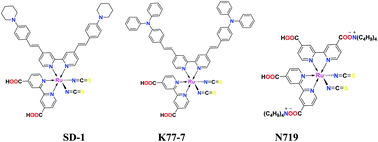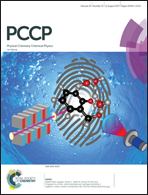A comparative study of the influence of N,N′-dialkyl vs. N,N′-diaryl-based electron donor ancillary ligands on photocurrent and photovoltage in dye-sensitized solar cells (DSSCs)†
Abstract
In this study, we report the synthesis of a novel heteroleptic Ru(II)-sensitizer, (Ru(2,2′-bipyridine-4,4′-dicarboxylic acid)-4,4′-bis(4-piperidin-1-yl)phenyl ethenyl)-(2,2′-bipyridine) (NCS)2, denoted as SD-1; moreover, its photophysical, electrochemical, and photovoltaic performances were compared with those of N719 and K77-7 (N,N′-diaryl Ru-sensitizer, namely Ru(2,2′-bipyridine-4,4′-dicarboxylic-acid)-4,4′-bis(2-(4-N,N′-diphenylaminophenyl)ethenyl)-2,2′-bipyridine (NCS)2). The photovoltaic performance of SD-1 outperformed those of N-719 and K77-7, particularly in the red region, and the overall efficiency of SD-1 was 8.5% as compared to 8.0% of K77-7 and 7.7% of N719 under the same experimental device conditions. The superior light harvesting efficiency of SD-1 can be attributed to the strong electron donor sp3-nitrogen, which is attached to two sp3-carbons (dialkyl), whereas in the case of K77-7, all carbon atoms attached to the sp3-nitrogen are sp2, which decrease the electron density on the latter and minimize the electron-donating power of the ancillary ligand in K77-7. To gain a quantitative understanding of the electron density on nitrogen in SD-1 and K77-7, first-principle calculations using molecular and thermodynamic descriptors, such as frontier molecular orbitals, ground-state oxidation potential (GSOP), excited-state oxidation potential (ESOP), optical gap (E0–0), and charge distributions, were conducted in solution. In addition, for understanding the anchored structures of dyes on Ti24O48, density functional theory (DFT) and time-dependent density functional theory (TD-DFT) were utilized. Results of computational studies are in excellent agreement with the experimental results, which can be used as a screening tool for the design of more efficient molecular motifs for DSSCs.



 Please wait while we load your content...
Please wait while we load your content...